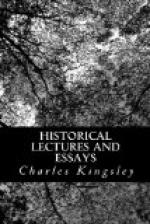That life is not as idle ore,
But heated hot with burning fears,
And bathed in baths of hissing tears,
And battered with the strokes of
doom
To shape and use.
But how did these wild Vikings become Christian men? It is a long story. So stanch a race was sure to be converted only very slowly. Noble missionaries as Ansgar, Rembert, and Poppo, had worked for 150 years and more among the heathens of Denmark. But the patriotism of the Norseman always recoiled, even though in secret, from the fact that they were German monks, backed by the authority of the German emperor; and many a man, like Svend Fork-beard, father of the great Canute, though he had the Kaiser himself for godfather, turned heathen once more the moment he was free, because his baptism was the badge of foreign conquest, and neither pope nor kaiser should lord it over him, body or soul. St. Olaf, indeed, forced Christianity on the Norse at the sword’s point, often by horrid cruelties, and perished in the attempt. But who forced it on the Norsemen of Scotland, England, Ireland, Neustria, Russia, and all the Eastern Baltic? It was absorbed and in most cases, I believe, gradually and willingly, as a gospel and good news to hearts worn out with the storm of their own passions. And whence came their Christianity? Much of it, as in the case of the Danes, and still more of the French Normans, came direct from Rome, the city which, let them defy its influence as they would, was still the fount of all theology, as well as of all civilisation. But I must believe that much of it came from that mysterious ancient Western Church, the Church of St. Patric, St. Bridget, St. Columba, which had covered with rude cells and chapels the rocky islets of the North Atlantic, even to Iceland itself. Even to Iceland; for when that island was first discovered, about A.D. 840, the Norsemen found in an isle, on the east and west and elsewhere, Irish books and bells and wooden crosses, and named that island Papey, the isle of the popes—some little colony of monks, who lived by fishing, and who are said to have left the land when the Norsemen settled in it. Let us believe, for it is consonant with reason and experience, that the sight of those poor monks, plundered and massacred again and again by the “mailed swarms of Lochlin,” yet never exterminated, but springing up again in the same place, ready for fresh massacre, a sacred plant which God had planted, and which no rage of man could trample out—let us believe, I say, that that sight taught at last to the buccaneers of the old world that there was a purer manliness, a loftier heroism, than the ferocious self-assertion of the Berserker, even the heroism of humility, gentleness, self-restraint, self-sacrifice; that there was a strength which was made perfect in weakness; a glory, not of the sword but of the cross. We will believe that that was the lesson which the Norsemen learnt, after many a wild and blood-stained




